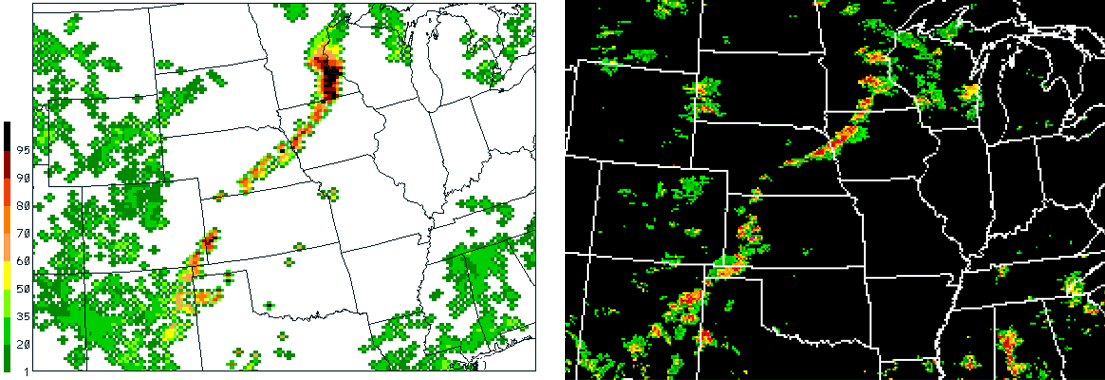EFP: 2001 Spring Experiment Summary
Working Hypotheses
- Numerical modelers can learn to incorporate more operational relevance in their research efforts if they work closely with forecasters in an experimental forecasting exercise.
- Operational forecasters can make more skillful interpretations of numerical model output if they work with numerical modelers in an experimental forecasting exercise.
Specific Objectives
- Research perspective: To develop methods to assess subjective impressions of model forecast skill in a quantitative manner for comparison with current objective verification metrics.
- Operational perspective: To investigate whether mesoscale numerical modelers can have a positive impact on forecasts of convective initiation and evolution by providing expert interpretation of mesoscale model output during the forecast preparation process.
Preliminary Results
- Panels of experts were assembled to perform subjective assessments of both operational and experimental forecast models. Results were shared with NCEP model developers to provide unique insight into model performance in the context of the specialized responsibilities of SPC forecasters.
- Ensemble forecasting techniques were introduced to SPC forecasters.
- Modeling experts were judged to have a positive impact in the forecast-preparation process by assisting in forecaster interpretation of model output, motivating these follow-up measures:

A 24 h forecast of parameterized updraft mass flux (LEFT), a unique prediction field from an experimental version of the Eta model, shows good agreement with radar depiction (RIGHT) of severe thunderstorms from MN into eastern NE on the evening of May 9, 2001, providing forecasters with excellent guidance in forecasting the development of these storms. [+]
Payoff
- NSSL modeling experts were invited to lecture on convective parameterization during formal SPC forecaster training exercises.
- Convective parameterization algorithms from operational and experimental versions of the Eta model were extracted and converted into 1-D diagnostic routines, which were incorporated into operational SPC sounding diagnostic software.
Related Publications
- Baldwin, M. E., and M. S. Wandishin, 2002: Determining the resolved spatial scales of Eta model precipitation forecasts. Preprints, 15th Conference on Numerical Weather Prediction, San Antonio, TX, Amer. Meteor. Soc., 85–88.
- Baldwin, M. E., and J. S. Kain, 2006: Sensitivity of several performance measures to displacement error, bias, and event frequency. Wea. Forecasting, 21, 636–648.
- Baldwin, M. E., S. Lakshmivarahan, and J. S. Kain, 2002: Development of an “events-oriented” approach to forecast verification. Preprints, 15th Conference on Numerical Weather Prediction, San Antonio, TX, Amer. Meteor. Soc., 210–213.
- Bukovsky, M. S., P. R. Janish, J. S. Kain, and M. E. Baldwin, 2002: Evaluation of Eta model forecasts of mesoscale convective systems. Preprints, 15th Conference on Numerical Weather Prediction, San Antonio, TX, Amer. Meteor. Soc., J121–J124.
- Bukovsky, M. S., J. S. Kain, and M. E. Baldwin, 2006: Bowing convective systems in a popular operational model: Are they for real? Wea. Forecasting, 21, 307–324.
- Kain, J. S., M. E. Baldwin, and S. J. Weiss, P. R. Janish, J. A. Hart, and A. Just, 2002: Grassroots science and technology transfer in a collaborative research/operational environment. Preprints, 15th Conference on Numerical Weather Prediction, San Antonio, TX, Amer. Meteor. Soc., J1–J6.
- Kain, J. S., M. E. Baldwin, and S. J. Weiss, P. R. Janish, M. P. Kay, and G. Carbin, 2003: Subjective verification of numerical models as a component of a broader interaction between research and operations. Wea. Forecasting, 18, 847–860.
- Kain, J. S., P. R. Janish, S. J. Weiss, M. E. Baldwin, R. S. Schneider, and H. E. Brooks, 2003: Collaboration between forecasters and research scientists at the NSSL and SPC: The Spring Program. Bull. Amer. Meteor. Soc., 84, 1797–1806.

